11 Historic Hotel Bars, Taverns, and Speakeasies
Across the United States, historic hotels are home to many of the nation’s most historic bars. These are venues where locals and travelers alike have gathered to relax and unwind for decades—even centuries. The selection of 11 historic bars presented in this guide was inspired by the recent publication of The 2025 Top 25 Historic Hotels of America Most Historic Bars, Taverns, and Speakeasies list. Historic Hotels of America is the official program of the National Trust for Historic Preservation for the celebration and promotion of the country’s finest historic hotels, resorts, and inns.
Beekman Arms and Delamater Inn (Rhinebeck, New York | 1766)
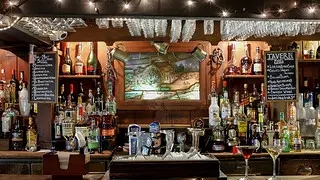
photo by: Historic Hotels of America
View of the bar area at The Tavern at the Beekman Arms and Delamater Inn.
The Tavern at Beekman Arms and Delamater Inn is an American tavern with a legacy dating back to 1704. Today, it invites visitors of the Rhinebeck Village Historic District to share a drink or a meal in the same space where George Washington, Philip Schuyler, Benedict Arnold, and Alexander Hamilton did in the 18th century. The Tavern is the most historic part of the Beekman Arms. The current Beekman Arms structure dates to 1766 but visitors have the chance to peek at a stained-glass depiction of the tavern as it looked in 1704, hung behind the bar. (National Register of Historic Places)
The Menger Hotel (San Antonio, Texas | 1859)
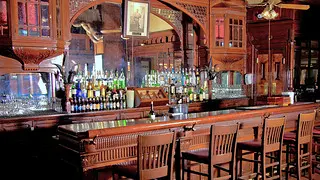
photo by: Historic Hotels of America
View of the Menger Bar at The Menger Hotel.
Menger Bar, in the Menger Hotel opened in 1887 and is a replica of the pub in London’s House of Lords, is San Antonio’s oldest continuously operating saloon. In 1898, Colonel Leonard Wood and his Lieutenant Colonel (and future President of the United States), Theodore Roosevelt, set up an enlistment table at Menger Bar. They recruited over 1,250 men to form the Rough Riders. Visitors today can still see the bullet holes where Roosevelt fired his gun to get the crowd’s attention. (National Register of Historic Places)
The Mission Inn Hotel & Spa (Riverside, California | 1876)
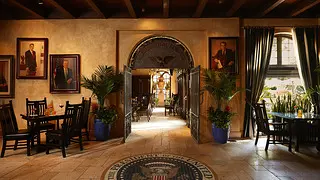
photo by: Historic Hotels of America
View through the Presidential Lounge at The Mission Inn.
The sumptuous Presidential Lounge at the Mission inn Hotel & Spa was originally a spacious two-story, four-bedroom family suite. In 1903, President Theodore Roosevelt stayed in the suite—and even helped in a ceremonial replanting of one of Riverside's parent navel orange trees the next day. Decades later, the Nixons were married in the same space where Roosevelt slept. Now transformed into a bar and lounge, the venue celebrates its history with portraits of the presidents who have visited the hotel over the years and patrons can order form the presidential cocktail menu, featuring drinks like W.H. Taft’s Soixante Quinze and Herbert Hoover’s Honey Buzz. (National Historic Landmark)
Hotel Monteleone (New Orleans, Louisiana | 1886)
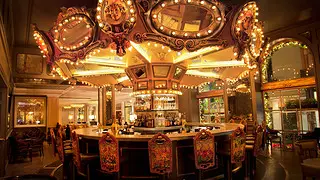
photo by: Historic Hotels of America
The Carousel Bar at Hotel Monteleone.
Located in the historic French Quarter, the world-famous Carousel Bar opened inside Hotel Monteleone as the city’s first and only rotating bar in 1949. Over the years, redesigns transformed the modern bar into the ostentatious merry-go-round that it is today. Guests lucky enough to find an empty seat at the bar (or with the fortitude to stand in line) enjoy a gentle rotation every 15 minutes. The hotel’s signature drink, the Vieux Carre cocktail, was invented at Hotel Monteleone in 1938 by Head Bartender Walter Bergeron.
The Algonquin Hotel Times Square, Autograph Collection (New York, New York | 1901)
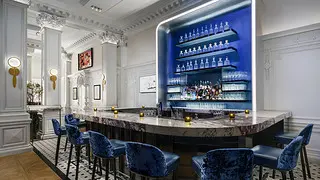
photo by: Historic Hotels of America
View of the Blue Bar at the Algonquin Hotel.
Since 1933, The Blue Bar at the Algonquin Hotel Times Square has been a Times Square mainstay, a place where Broadway stars and artists can relax under the cool glow of azure-hued lighting. Why blue? Frequent patron and actor John Barrymore believed that the cooler hues were more flattering for his pale complexion and persuaded the hotel to install blue lighting gels. This theatrical touch gave the bar its name and signature glow, which remains a beloved feature to this day. The bar’s legacy is also intertwined with the literati of the famed Algonquin Round Table, whose evenings routinely spilled into The Blue Bar. (Designated Historic by the NYC Landmarks Preservation Commission)
Omni Mount Washington (Bretton Woods, New Hampshire | 1902)
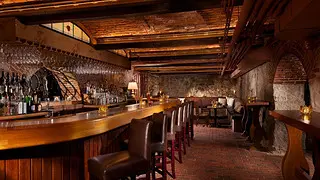
photo by: Historic Hotels of America
View of The Cave at the Omni Washington Bretton Woods.
Beneath a White Mountains resort hotel, The Cave is a Prohibition-era speakeasy with stone walls and a storied past. Originally constructed in 1902 as a squash court, it was later transformed into a bar and became one of the most famous speakeasies in the region during Prohibition. The bar features several secretive elements, including a trapdoor for storing whiskey and a removable brick in the wall that gave patrons a view of the road to spot any police approaching. Today, the Cave’s signature drink is Prohibition Punch, a nod to its colorful past. (National Historic Landmark)
Fairmont San Francisco (San Francisco, California | 1907)
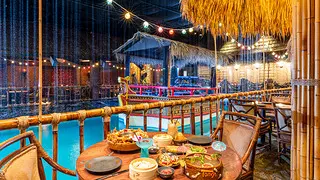
photo by: Historic Hotels of America
The Tonga Room at the Fairmont Hotel.
The Tonga Room & Hurricane Bar is a legendary tiki bar set around an artificial lagoon in the heart of one of San Francisco’s most historic luxury hotels. It dates to the late 1940s, when the hotel owner converted the pool area into a restaurant and bar named after the S.S. Tonga, a real ship found moored in the mud nearby. By the 1950s, locals and visitors alike were enjoying tropical drinks and gazing into the blue water of the former Fairmont Plunge pool, featuring a floating stage for musicians. To this day, the venue wows guests with staged thunderstorms, complete with simulated lightning and misty rain. (National Register of Historic Places)
The Royal Hawaiian, A Luxury Collection Resort (Honolulu, Hawaii | 1927)
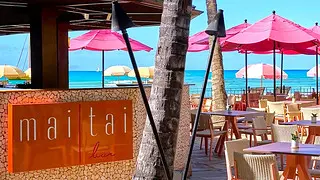
photo by: Historic Hotels of America
The Mai Tai Bar at the Royal Hawaiian.
Steps from Waikiki Beach, the open-air Mai Tai Bar at the historic "Pink Palace of the Pacific" is named after its signature drink, a variation of the classic Mai Tai. The drink was invented by Victor Bergeron (“Trader Vic”) in 1944 and he reinvented the cocktail for the hotel several years later, adding more pineapple juice to his original recipe. The first known Mai Tai served in Hawaii was enjoyed at this rosy Moorish Revival hotel in 1953 and today the menu boasts a variety of variations on the classic cocktail.
Hilton Baton Rouge Capitol Center (Baton Rouge, Louisiana | 1927)
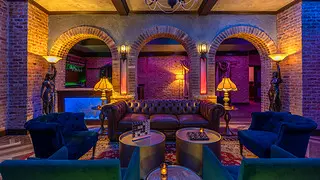
photo by: Historic Hotels of America
The Tunnel Speakeasy at the Hilton Baton Rouge.
Tucked beneath the historic hotel, The Tunnel Speakeasy is located inside an actual underground tunnel once used by Louisiana governors and legislators—including Huey Long—to avoid the press and to move discreetly to the building across the street. Today, original brick archways, low lighting, and vintage décor create a rich, Prohibition-era atmosphere. Memorabilia throughout the bar highlights the hotel’s storied past, including visits from figures like Huey Long and John F. Kennedy. Space is limited and reservations are required. (National Register of Historic Places)
Hilton Cincinnati Netherland Plaza (Cincinnati, Ohio | 1931)
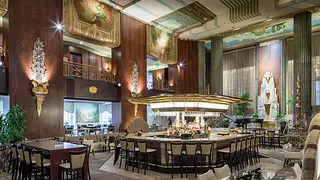
photo by: Historic Hotels of America
The Lounge at the Hilton Cincinnati
The Lounge at 1931 in downtown Cincinnati is a stunning tribute to Art Deco-style design, neoclassical art, and history. The hotel was dry when it opened in 1931, but its breathtaking interior drew visitors from around the world. Surrounding the bar in the central Palm Court are Louis Grell’s 10 original murals, depicting 18th century French figures, with outlines of notable Cincinnati landmarks subtly woven into the depicted scenes. Also notable is the ziggurat-shaped fountain at the far end of the Palm Court, crafted by Rookwood Pottery, which commands attention with its detailed ram’s head flanked by majestic sea horses wearing lotus crowns. (National Historic Landmark)
The Wort Hotel (Jackson, Wyoming | 1941)
%20Jackson,%20Wyoming%2016x9.webp)
photo by: Historic Hotels of America
The Silver Dollar Bar at The Wort Hotel.
The Silver Dollar Bar at the Wort Hotel has entertained and enticed "locals, visitors, cowboys, politicians and millionaires” since 1950 and the earliest days of Jackson Hole tourism. The name comes from the 65-foot serpentine bar, inlaid with over 2,000 1921 silver dollars from the Denver mint. Permanently stuck to the bar top, the coins were shrunk with dry ice and then inserted into holes in the Formica, drilled to be slightly smaller than the diameter of the coins. When the silver dollars expanded, they were solidly encased within the Formica bar. (National Register of Historic Places)
Donate Today to Help Save the Places Where Our History Happened.
Donate to the National Trust for Historic Preservation today and you'll help preserve places that tell our stories, reflect our culture, and shape our shared American experience.



